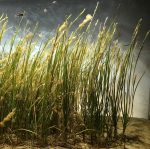 Also known as seawrack and tapegrass, eelgrass is a submerged perennial native to shallow marine environments from subtropical to subpolar regions of North America and Eurasia. It is a member of the eelgrass family, Zosteraceae, 1 of 4 seagrass families. It has a thick, creeping rhizome 3/4-2″ long with many roots and nodes, and ribbon-like leaves up to 47″ long and with rounded tips. Male and female flowers are produced on the same plant in late spring and nutlets containing seeds are produced on spathes that break off, rise to the surface, drift, and release the seeds. Photo Credit Wikipedia
Also known as seawrack and tapegrass, eelgrass is a submerged perennial native to shallow marine environments from subtropical to subpolar regions of North America and Eurasia. It is a member of the eelgrass family, Zosteraceae, 1 of 4 seagrass families. It has a thick, creeping rhizome 3/4-2″ long with many roots and nodes, and ribbon-like leaves up to 47″ long and with rounded tips. Male and female flowers are produced on the same plant in late spring and nutlets containing seeds are produced on spathes that break off, rise to the surface, drift, and release the seeds. Photo Credit Wikipedia
The Hebrew word ס֖וּף is usually translated as weed and seaweed and is generally thought to be eelgrass, Zostera marina, that is usually disliked by swimmers and bathers because of its slimy and twining nature.
Jonah 2: 5 (NIV) Three days and nights after being swallowed by the fish, Jonah cries out to God and describes his troubled experience.
“The engulfing waters threatened me, the deep surrounded me; seaweed was wrapped around my head.”
Eelgrass likes full sun and sandy sediment in saline water 16′ or less deep. It is susceptible to damage by Labyrinthula zosterae. Reproduction is by seed and division and large colonies may be formed. Eelgrass is valued for its many uses including as packing material, stuffing, food for humans and animals, fertilizer, insulation, and roof thatching material. In addition, eelgrass is useful for soil stabilization and provides habitats for blue crabs, mussels, and fish.
The genus name, Zostera, comes from the Greek word, zōstēr, meaning girdle. The specific epithet, marina, comes from the Latin word mare, meaning sea and refers to it habitat.